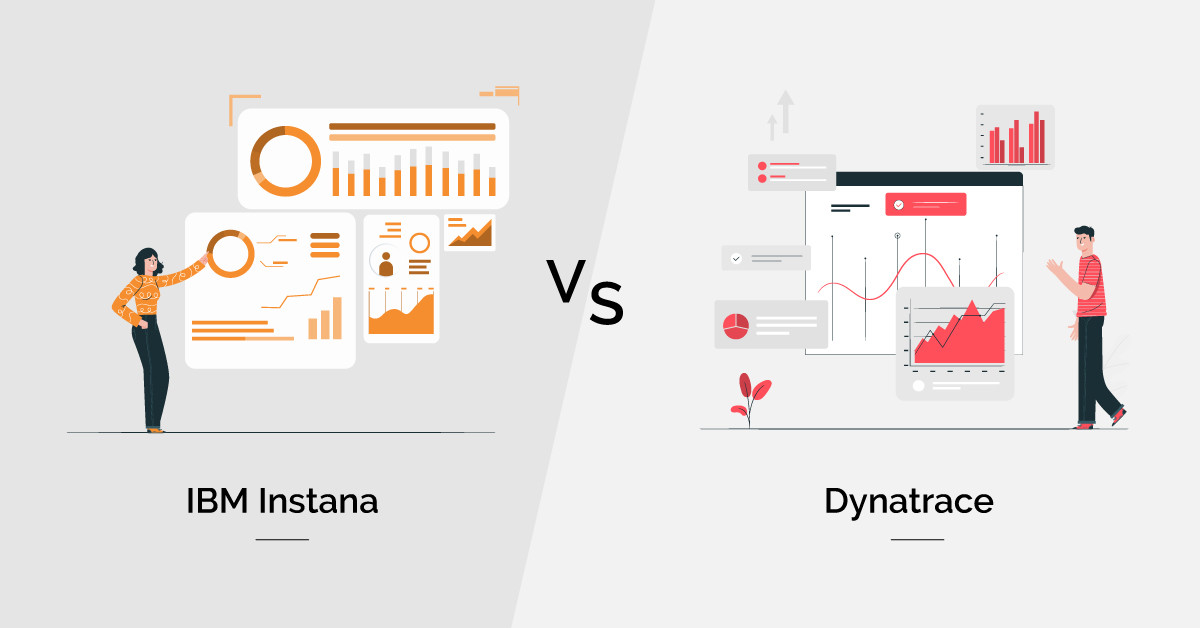
Comparing the Top APM Tools: IBM Instana vs. Dynatrace
Application Performance Monitoring (APM) has become indispensable to modern software development and operations. APM goes beyond system availability, service performance, and response times. It empowers organizations to enhance user experiences at the scale of modern computing by using automated and intelligent observability. IBM Instana vs. Dynatrace are the two leading APMs. In this blog post, we’ll compare these two top APM tools to help you make an informed decision for your organization.
IBM Instana
IBM Instana is a fully automated APM solution that addresses the complexities of overseeing microservices and cloud-native applications. Instana excels at rendering your applications and services visible, providing context to the insights it gathers, and ultimately allowing you to make informed and intelligent decisions based on that information.
Key Features:
- Automatic Discovery and Monitoring: IBM Instana seamlessly integrates with your environment, automatically detecting and monitoring applications, services, and infrastructure components. This reduces the manual effort required for setup and maintenance.
- Full-Stack Observability: Instana provides full-stack observability, including code-level insights. It monitors applications, containers, and microservices, allowing you to access individual components to identify bottlenecks and performance issues.
- Automation and Intelligence: It uses machine learning algorithms to identify unusual behavior in your applications and infrastructure. This helps organizations address potential problems before they impact users proactively.
- Root Cause Analysis: Instana excels in root cause analysis. It identifies issues and provides actionable insights into why they occurred, making it easier for development and operations teams to collaborate on issue resolution.
- Kubernetes and Docker Support: For organizations embracing container orchestration with Kubernetes and Docker, Instana provides immense support. It provides visibility into the performance of containerized applications, making it an excellent choice for containerized microservices architectures.
- Continuous Integration and Continuous Deployment (CI/CD) Integration: Instana seamlessly integrates with popular CI/CD tools like Jenkins, allowing businesses to include performance testing in their development pipeline. This enables early detection of performance issues in your code.
Pros of IBM Instana:
- Automatic discovery and monitoring reduce setup overhead.
- AI-powered anomaly detection helps in proactive issue resolution.
- Excellent support for Kubernetes and Docker environments.
- Full-stack observability provides deep insights into application performance.
Cons of IBM Instana:
- Pricing can be on the higher side for small to medium-sized businesses.
- The learning curve for advanced features can be steep.
Dynatrace
Dynatrace is a robust application monitoring tool that ensures consistent system performance and availability. It uses digital applications to stay relevant with technology and monitors every transaction from the browser to the database. It also monitors infrastructure, quickly identifying server, database, and code performance issues. Dynatrace’s complexity reflects its advanced technology, making it a powerful APM tool.
Key Features:
- Smartscrape Technology: Dynatrace Smartscape is a component of the Dynatrace platform, offering a graphical depiction of dependencies and relationships among various elements within an application and its environment. It is a visualization tool for the entire application ecosystem, including applications, services, processes, and infrastructure.
- AI-Powered Problem Detection: It uses AI and machine learning to detect performance data, uncovering hidden patterns and correlations that may elude human observation. This capability enables Dynatrace to identify potential issues impacting application and infrastructure performance, ultimately furnishing users with valuable insights and recommendations to enhance overall performance.
- Davis AI: Davis AI is Dynatrace’s AI engine, identifying problems and providing actionable insights and recommendations for issue resolution. This feature helps teams prioritize and resolve issues before they occur.
- Support cloud, hybrid, and on-prem monitoring: It offers a versatile monitoring suite tailored to support cloud, hybrid, and on-premises setups. It oversees the performance of cloud-based applications and infrastructure in the cloud, including platforms like AWS, Azure, and GCP. Dynatrace extends its monitoring capabilities to on-premises and cloud components in hybrid environments, offering a holistic perspective on system performance and well-being. This proves invaluable for organizations migrating from on-premises to cloud systems, streamlining monitoring across both environments within a unified platform.
- User Experience Monitoring: Dynatrace includes user experience monitoring, allowing you to track the performance of your applications from the user’s perspective. This feature is essential for ensuring a seamless user experience.
Pros of Dynatrace:
- Comprehensive Smartscrape technology provides a holistic view of your application ecosystem.
- Davis AI offers actionable insights for issue resolution.
- Robust support monitoring in cloud, hybrid, and on-premises environments.
- User experience monitoring ensures a focus on end-user satisfaction.
Cons of Dynatrace:
- Like IBM Instana, Dynatrace can be relatively expensive for smaller businesses.
- The user interface can be overwhelming for newcomers, requiring some learning to navigate effectively.
IBM Instana vs. Dynatrace: A Head-to-Head Comparison
- Ease of Setup and Use: Instana and Dynatrace offer automatic discovery and monitoring, simplifying the initial setup process. However, some users find Dynatrace’s interface initially complex, while Instana provides a more straightforward onboarding experience.
- Pricing: Pricing for both APM tools can vary widely based on the scale of your environment and the features you require. Smaller businesses find both solutions relatively expensive, while larger enterprises may justify the cost of the comprehensive feature set.
- AI and Machine Learning: Both tools leverage AI and machine learning for anomaly detection, but the implementation differs slightly. Dynatrace’s Davis AI provides more actionable insights and recommendations, giving it a slight edge in this category.
- Kubernetes and Container Support: Instana and Dynatrace both excel in providing visibility into containerized applications. However, Instana’s roots in cloud-native environments give it a slightly more specialized edge in this area.
- User Experience Monitoring: Dynatrace’s focus on user experience monitoring is a standout feature, ensuring that your applications meet end-user expectations. Instana also provides this capability, but Dynatrace’s implementation is more user-centric.
Conclusion
Choosing between IBM Instana and Dynatrace depends on your organization’s specific needs and budget. Both tools offer robust APM capabilities with automatic discovery, AI-driven insights, and excellent container support.
Ultimately, the decision should consider factors like the complexity of your environment, the level of AI-driven insights you require, and your organization’s willingness to invest in APM. It’s advisable to leverage free trials or proofs of concept to evaluate how each tool fits your unique use cases before making a final decision. Regardless of your choice, investing in APM is crucial to ensuring high-performing, reliable applications in today’s competitive digital landscape.


More on Technology
Innominds and Qualcomm Collaborate to Drive Enterprise Digital Transformation with High-Compute Edge AI Platform
-
Team Eela



